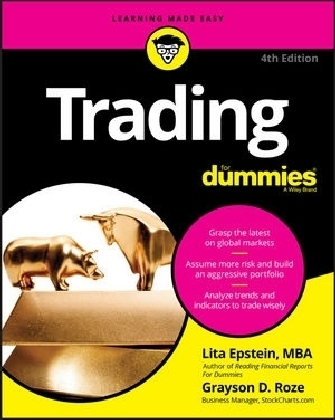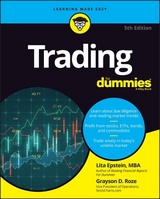
Trading For Dummies, 4th Edition
John Wiley & Sons Inc (Verlag)
978-1-119-37031-4 (ISBN)
- Titel erscheint in neuer Auflage
- Artikel merken
Lita Epstein, MBA, is the author of more than 35 books, including Bookkeeping For Dummies and Reading Financial Reports For Dummies. Grayson D. Roze has worked in the financial services industry for StockCharts.com since 2012. He now serves as a business manager at the company. He is the author of Tensile Trading: The 10 Essential Stages of Stock Market Mastery.
Introduction 1
About This Book 2
Foolish Assumptions 2
Icons Used in This Book 3
Beyond the Book 3
Where to Go from Here 4
Part 1: Getting Started with Trading 5
Chapter 1: The Ups and Downs of Trading Stocks 7
Distinguishing Trading from Investing 8
Seeing Why Traders Do What They Do 8
Successful Trading Characteristics 9
Tools of the Trade 10
Taking Time to Trade More Than Just Stocks 10
Position trading 10
Short-term swing trading 11
Day trading 12
Going Long or Short 12
Managing Your Money 12
Understanding Fundamental Analysis 13
Getting a Grip on Technical Analysis 14
Putting Trading Strategy into Practice 15
Trading at Higher Risk 17
Remembering to Have Fun! 17
Chapter 2: Exploring Markets and Stock Exchanges 19
Introducing the Broad Markets 19
Stock markets 20
Futures markets 20
Bond markets 21
Options markets 22
Reviewing Stock Exchanges 22
New York Stock Exchange (NYSE: ICE) 22
NASDAQ 24
Amex (now NYSE MKT LLC) 25
Electronic communications networks (ECNs) 26
Understanding Order Types 26
Market order 27
Limit order 27
Stop order 28
Stop-limit order 29
Good-’til-canceled order 30
Other order types 30
Chapter 3: Going for Broke(r): Discovering Brokerage Options 31
Why You Need a Broker 32
Exploring Types of Brokers and Brokerage Services 32
Full-service brokers 32
Discount brokers 34
Direct-access brokers 34
Proprietary trading firms 36
Futures brokers 36
Services to Consider When Choosing a Broker 36
Types of orders supported 36
Data tools 37
Charts 37
ECN access 38
Knowing the Types of Brokerage Accounts 38
Cash accounts 38
Margin accounts 38
Options 39
IRAs and other retirement accounts 39
Choosing the Right Broker for You 41
Considering more than price 41
Doing a little research 42
Understanding how you’ll be paying 43
Getting to Know the Rules 43
Margin requirements 43
Settling trades 45
Free riding 45
Chapter 4: Putting Your Key Business Tool to Work: The Computer 47
Making Use of Your Computer 48
Identifying trading candidates 48
Managing your account 49
Improving your trades 49
Finding Price Charts 49
Checking out Internet charts with delayed prices 51
Considering Internet charts with real-time prices 51
Looking into charting software 52
Digging Up Fundamental Data 53
Accessing Analyst Reports 54
Selecting a Trading Platform 54
Browser-based trading environments 55
Integrated trading platforms 56
Features to consider 57
Determining Computer Requirements 58
Weighing Windows versus Mac versus Linux 58
Configuring your computer system 59
Accessing the Internet 61
Picking a browser 61
Securing your computer 61
Part 2: Reading the Fundamentals: Fundamental Analysis 63
Chapter 5: Fundamentals 101: Observing Market Behavior 65
The Basics of the Business Cycle 66
Understanding how periods of economic growth and recession are determined 67
Using economic indicators to determine the strength of the economy 68
Relating bull markets and bear markets to the economy 70
Employing a Sector Rotation Strategy 70
Early recovery 71
Full recovery 72
Early recession 72
Full recession 73
Sector rotation 73
Understanding Economic Indicators 74
Interest rates 75
Money supply 76
Inflation rate 76
Deflation 78
Jobless claims 79
Consumer confidence 80
Business activity 80
Using Data from Economic Indicators 82
Chapter 6: Digging Into Fundamental Analysis 85
Checking Out the Income Statement 86
Revenues 87
Cost of goods sold 87
Gross margins 88
Expenses 89
Interest payments 90
Tax payments 91
Dividend payments 91
Profitability 92
Looking at Cash Flow 93
Operating activities 94
Financing activities 95
Investment activities 96
Scouring the Balance Sheet 97
Analyzing assets 97
Looking at debt 98
Reviewing goodwill 99
Determining Stock Valuations 99
Earnings 100
Earnings growth rate 100
Figuring Your Ratios: Comparing One Company’s Stock to Another 102
Price/earnings ratio 102
Price/book ratio 103
Return on assets 103
Return on equity 103
Chapter 7: Listening to Analyst Calls 105
Getting to Know Your Analysts 106
Buy-side analysts: You won’t see them 106
Sell-side analysts: Watch for conflicts 106
Independent analysts: Where are they? 109
The Importance of Analysts 109
Tracking how a company’s doing 110
Providing access to analyst calls 110
Pointers for Listening to Analyst Calls 112
Understanding the analysts’ language 113
Developing your listening skills 114
Locating Company Calls 117
Identifying Trends in the Stock-Analyst Community 117
Part 3: Reading the Charts: Technical Analysis 119
Chapter 8: Seeing Is Believing: An Introduction to Technical Analysis 121
Understanding the Methodology 122
Finding everything in the price 123
Seeing that price movements are not always random 124
Balancing supply and demand 125
Understanding where you’ve been 125
Understanding where you’re headed 127
Answering the Detractors 128
Walking randomly 129
Trading signals known to all 129
Executing Your Trading Plan 130
Using StockCharts.com 131
Chapter 9: Reading Bar Charts Is Easy (Really) 135
Creating a Price Chart 136
Looking at a single price bar 137
Measuring volume 138
Coloring charts 140
Identifying Simple Single-Day Patterns 140
Single-bar patterns 140
Reversal patterns 142
Recognizing Trends and Trading Ranges 143
Discerning a trading range 144
Spotting a trend 145
Paying attention to time frame 146
Searching for Transitions 147
Support and resistance: The keys to trend transitions 147
Finding a breakout 149
Sipping from a cup and handle 151
Deciding what to do with a double bottom 152
An alternative double-bottom strategy 153
Looking at other patterns 154
Chapter 10: Following Trends to Boost Your Probability of Success 155
Identifying Trends 156
Supporting and Resisting Trends 157
Drawing trend lines to show support 158
Using channels 159
Trending and channeling strategies 160
Seeing Gaps 161
Common gap 162
Breakout or breakaway gap 162
Continuation gap 162
Exhaustion gap 163
Island gap 164
Waving Flags and Pennants 164
Withstanding Retracements 165
Three-step and five-step retracements 166
Subsequent trading ranges 167
Dealing with Failed Signals 168
Trapping bulls and bears 168
Filling the gaps 169
Deciding whether to reverse directions 169
Chapter 11: Calculating Indicators and Oscillators 171
The Ins and Outs of Moving Averages 173
Simple moving average 173
Exponential moving average 175
Comparing SMAs and EMAs 178
Interpreting and using moving averages 179
Support and resistance factors 181
Deciding the moving average time frame 182
Understanding Buy and Sell Pressure through Stochastic Oscillators 183
Calculating stochastic oscillators 183
Interpreting stochastic oscillators 184
Tracking Momentum with the MACD 185
Calculating the MACD 186
Using the MACD 187
Revealing Relative Strength 190
Calculating relative strength 190
Putting relative strength to work 191
Part 4: Developing Strategies for When to Buy and Sell Stocks 193
Chapter 12: Money Management Techniques: Building a More Robust Portfolio 195
Achieving Your Trading Goals with Smart Money Management 196
Managing Your Portfolio 197
Thinking of trading as a business 197
Recognizing the trader’s dilemma 198
Finding a better plan 199
Protecting Your Principal 201
Recovering from a large loss: It ain’t easy 202
Setting a target price for handling losses 203
Strategies for managing profitable trades 205
Understanding Your Risks 209
Market risks 209
Investment risks 210
Trading risks 210
Chapter 13: Combining Fundamental and Technical Analyses for Optimum Strategy 213
Seeing the Big Picture 214
Knowing when the Fed is your friend 215
Keeping an eye on industrial production 215
Watching sector rotation 216
Finding the dominant trend 220
Selecting Your Trading Stock 225
Trading Strategies 226
Trading the bullish transition 226
Trading in a bull market 227
Trading the bullish pullback 227
Trading the bearish transition 228
Trading in a bear market 228
Trading the bearish pullback 229
A hypothetical trading example 229
Chapter 14: Minimizing Trading Risks Using Exchange-Traded Funds 231
What Is an ETF? 231
Examining the advantages 232
Avoiding the flaws 233
Does Family Matter? 233
Market-weighted ETFs 234
Equal-weighted ETFs 235
Fundamentally weighted ETFs 235
Sector Rotation Strategies 236
Early recovery 236
Full recovery 236
Early recession 237
Full recession 237
Analyzing ETFs 237
Portfolio Construction 239
International trading with ETFs 239
Commodities and ETFs 239
Currency trading and ETFs 239
Leveraged ETFs 240
Inverse ETFs 240
Chapter 15: Executing Your Trades 241
Entering and Exiting Your Trade 241
Keeping straight the bid and the ask 243
Understanding the spread 244
Devising an effective order-entry strategy 244
Timing your trades: Entering orders after the market closes 247
Reviewing a week in the life of a trader 248
Selling Stocks Short 253
Avoiding Regulatory Pitfalls 254
Understanding trade-settlement dates 254
Avoiding free riding 255
Avoiding margin calls and forced sales 256
Avoiding pattern-day-trader restrictions 258
The Tax Man Cometh 258
Chapter 16: Developing Your Own Powerful Trading System 259
Understanding Trading Systems 260
Discretionary systems 261
Mechanical systems 261
Trend-following systems 262
Countertrend systems 263
Selecting System-Development Tools 264
Choosing system-development hardware 264
Deciding on system-development software 264
Finding historical data for system testing 266
Developing and Testing Trading Systems 267
Working with trend-following systems 267
Using breakout trading systems 270
Accounting for slippage 275
Keeping a Trading Journal 275
Evaluating Trading Systems for Hire 276
Part 5: Risk-Taker’s Paradise 279
Chapter 17: The Basics of Swing Trading 281
Selecting Stocks Carefully 281
Looking at Swing-Trading Strategies 283
Trading trending stocks 283
Trading range-bound stocks 287
Trading volatility 289
Money management issues 291
Using Options for Swing Trading 291
Getting a Grip on Swing-Trading Risks 293
Taxes (of course) 293
Pattern-day-trading rules apply 294
Chapter 18: The Basics of Day Trading 295
What Day Trading Is All About 296
Institutional day traders (market makers) 296
Retail day traders 296
Understanding Account Restrictions 299
The Fed’s Regulation T: Margin requirements 299
Settlement: No free rides 301
Strategies for Successful Day Trading 301
Technical needs 302
Trading patterns 302
Scalping 303
Trend traders 303
Recognizing That Risks Are High 303
Liquidity 304
Slippage 304
Trading costs 305
Taxes (of course) 306
Avoiding the Most Common Mistakes 307
Chapter 19: Doing It by Derivatives 311
Types of Derivatives: Futures and Options 312
Buy now, pay later: Futures 312
Wait and see: Options 316
Buying Options and Futures Contracts 321
Opening an account 321
Calculating the price and making a buy 322
Options for Getting Out of Options 323
Offsetting the option 323
Holding the option 324
Exercising the option 324
The Risks of Trading Options and Futures 325
Minimizing Risks 326
Chapter 20: Going Foreign (Forex) 329
Exploring the World of Forex 330
Types of currency traders 330
Why currency changes in value 331
What traders do 332
Understanding Money Jargon 333
Spot transactions 334
Forward transactions 334
Options 335
Looking at How Money Markets Work 336
Different countries, different rules 337
The almighty (U.S.) dollar 337
Organized exchanges 337
Taking Necessary Risks in the World Money Market 339
Understanding the types of risks 339
Seeking risk protection 342
Getting Ready to Trade Money 343
Part 6: The Part of Tens 345
Chapter 21: More Than Ten Huge Trading Mistakes 347
Fishing for Bottoms 347
Timing the Top 348
Trading against the Dominant Trend 349
Winging It 349
Taking Trading Personally 350
Falling in Love 350
Using After-Hours Market Orders 351
Chasing a Runaway Trend 351
Averaging Down 351
Ignoring Your Stops 352
Diversifying Badly 352
Enduring Large Losses 353
Chapter 22: Ten Trading Survival Techniques 355
Build Your Trading Tool Chest 355
Choose and Use Your Favorite Tools Wisely 356
Use Both Technical and Fundamental Analyses 357
Count on the Averages to Make Your Moves 357
Develop and Manage Your Trading System 358
Know Your Costs 358
Have an Exit Strategy 359
Watch for Signals, Don’t Anticipate Them 359
Buy on Strength, Sell on Weakness 360
Keep a Trading Journal and Review It Often 360
Index 361
| Erscheinungsdatum | 21.07.2017 |
|---|---|
| Verlagsort | New York |
| Sprache | englisch |
| Maße | 189 x 234 mm |
| Gewicht | 574 g |
| Themenwelt | Sachbuch/Ratgeber ► Beruf / Finanzen / Recht / Wirtschaft ► Geld / Bank / Börse |
| Wirtschaft ► Betriebswirtschaft / Management ► Finanzierung | |
| ISBN-10 | 1-119-37031-0 / 1119370310 |
| ISBN-13 | 978-1-119-37031-4 / 9781119370314 |
| Zustand | Neuware |
| Informationen gemäß Produktsicherheitsverordnung (GPSR) | |
| Haben Sie eine Frage zum Produkt? |
aus dem Bereich



